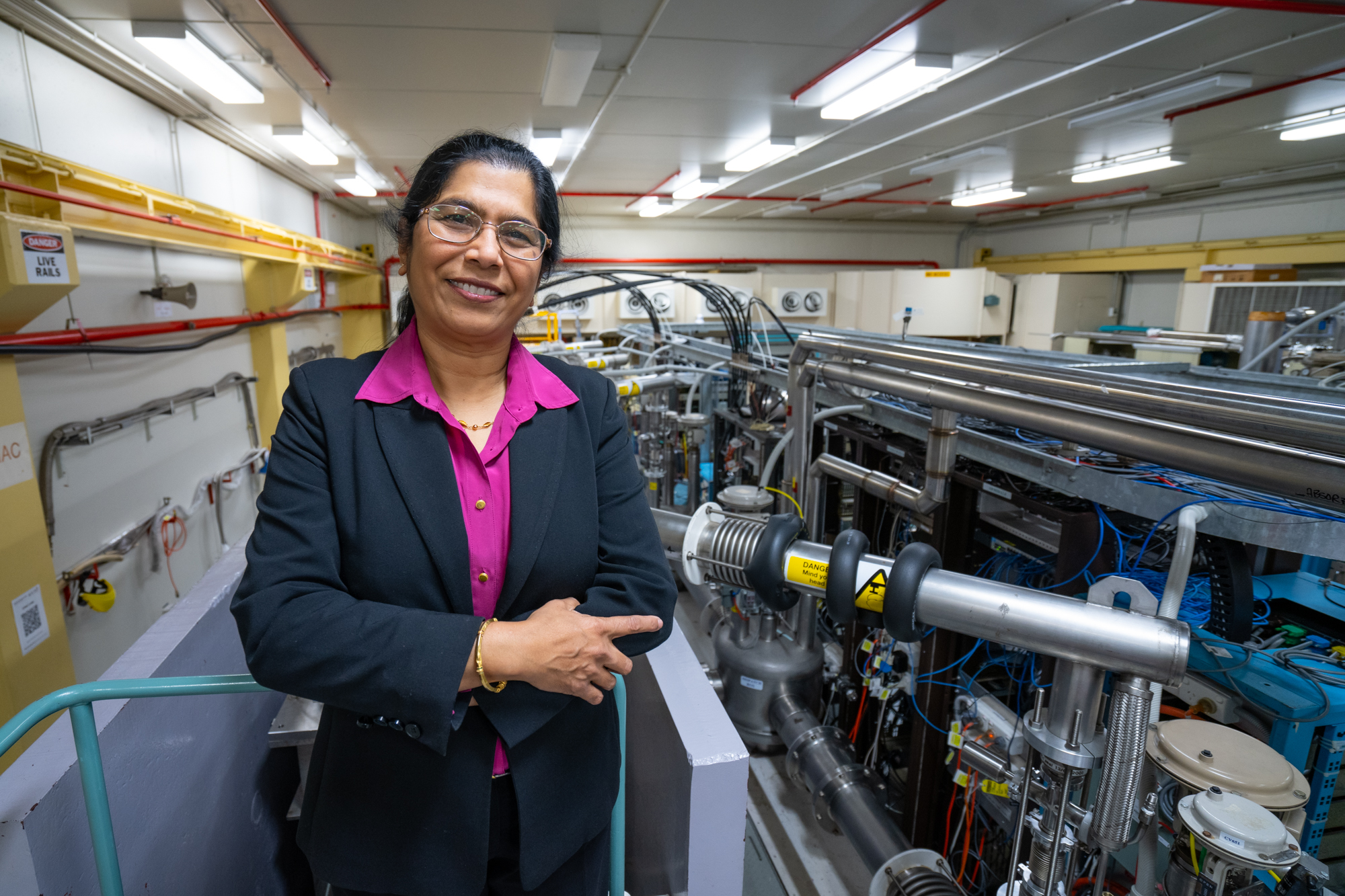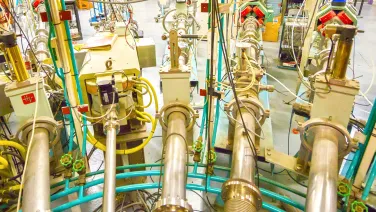Two towers of strength: looking up to the best in physics
When you see the Heavy Ion Accelerator Facility – which, if you live in Canberra, you almost certainly have – you probably don’t feel any particularly powerful emotions.
It’s the 40-metre tall rectangular tower conspicuously located among the low-rise campus buildings on the edge of Lake Burley Griffin. In terms of architecture, ‘functional’ is possibly the politest way to describe its appearance.
When Professor Mahananda Dasgupta looks up at the same tower, known as the HIAF, she feels something quite different.
“I feel very, very proud of it,” she says. “It is a tower of strength.”
Then she repeats, with emphasis: “A. Tower. Of. Strength.”
Professor Dasgupta is an experimental physicist at the ANU Research School of Physics, and the Director of the HIAF, which, she notes admiringly, hasn't even needed repainting in the 50 years since it was built.
An ion accelerator enables scientists to look inside an atom, beyond even the capabilities of an electron microscope. The HIAF is the largest and most powerful ion accelerator in Australia, and one of the three highest-voltage ion accelerators in the world.
Among its many achievements, the HIAF has helped researchers to unveil ancient climate records, discover evidence of nearby supernovae, trace and track soil erosion in Australia, and find the most efficient nuclear reaction to lead to the discovery of new elements. It’s also used for hands-on teaching and training in nuclear physics and its applications.
“It is here for the nation,” Professor Dasgupta says of the facility, supported by the Federal Government’s National Collaborative Research Infrastructure Strategy. “Quite simply, the accelerator’s capabilities are necessary for our national advancement.”
Professor Dasgupta would like the world-class reputation and capabilities of the HIAF to be better known within Australia. When she speaks with politicians about her research, she says, they assume she travels to CERN.
“Researchers from many countries including Germany, the US, France and Japan come to Australia to collaborate with us because we are known for our brand, which is: we advance frontiers.
“And our students are very, very sought after by international labs, because of our wide-ranging hands-on training. You can stand them in front of almost anything in a laboratory, and they will solve the problem.”
It was the international reputation of experimental physics at ANU that brought Professor Dasgupta herself to Australia.
“It’s a funny story actually,” she says. “I was finishing my thesis at Bombay, where I was the first PhD out of their accelerator lab, and I was giving my thesis seminar.
“And I said, ‘Look, there is an idea, where if you could make exquisitely precise measurements then that will answer a highly sought-after question in quantum mechanics, except the data quality is so poor, that this will not be achieved very soon.’ That is still what’s written at the end of my thesis.
“And then someone at the end of my talk says, ‘Oh, by the way, have you seen the publication in Physical Review Letters yesterday? A group from the Australian National University has made the measurement that you are saying is not possible.’
“And I said, ‘Well, there you go! I stand corrected.’ This is how science progresses.”
In the next issue of Nature magazine, there was an advertisement for a position with that ground-breaking team at ANU and Professor Dasgupta applied. She has remained here ever since.
The tangles of wires, pipes and tubes of the HIAF have provided the backdrop to her research career, but to Professor Dasgupta, it’s more than just a workplace.
“If you asked me to leave my house and buy another house, sure, I’d do it. But if you asked me to change my lab, I would say no. I would not swap my career for anything else.”

And now, the capabilities of the HIAF and its scientists are needed more than ever.
“If we are going into nuclear science and technology in a big way, our international credibility in experimental nuclear science depends on the HIAF. We have important national projects coming up in defence, in the space industry, and in cancer treatment using accelerated protons. All these projects are underpinned by nuclear science and supported by accelerators.
“It is important that people know the breadth and depth of what we can achieve.”
There is more than one tower of strength in this story, and it’s important people know that too.
When Professor Dasgupta arrived in Canberra in 1992, she was the only woman at HIAF.
She faced structural disadvantages, but went on to become the first woman to secure tenure in physics at the University, which, shockingly was not until 2003. Now, she is a Fellow of both the Australian Academy of Science and the American Physical Society, and a recipient of the prestigious Pawsey Medal.
“It is very slow, but things have changed,” she says of the sexism – and racism – she has faced along the way. “It is changeable.”
Professor Dasgupta gets frustrated about this sometimes, that being a woman in physics is still noteworthy, a topic on which she speaks regularly.
“I am a physicist first,” she says. “But I have a platform as a female physicist to articulate the problems I see, so I need to use it.”
This is an important project for the nation, too.
“The kind of STEM workforce numbers that we are talking about which will be required for our future capabilities in health, in space, in national security, it is such large numbers,” she says.
“As a nation, we need to make sure women can be part of that opportunity.”
This is, after all, how science progresses.



